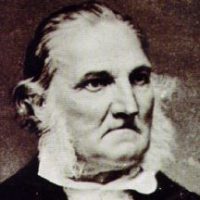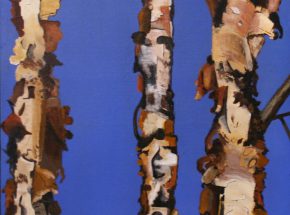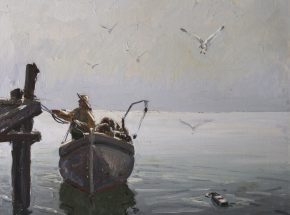

John James Audubon was born April 26, 1785, in Les Cayes, Santo Domingo (now Haiti), the illegitimate son of French sea captain Jean Audubon and a servant, Jeanne Rabine. In 1789, a few years after the death of his mother, he was taken to France and raised by his father and stepmother. During a happy childhood at Coueron, near Nantes, he studied geography, fencing, and mathematics, but was most enthusiastic about exploring the out-of-doors and collecting and drawing birds’ nests, eggs, and other curiosities. Audubon claimed to have studied with the French neo-classical painter Jacques-Louis David, but there is no documentation to support this.
In 1803 he was sent to America to operate Mill Grove, a farm near Philadelphia that his father had purchased in 1789. Through mismanagement and neglect Audubon lost the farm, thus beginning a long series of early commercial failures for the young man, who preferred to devote his time to shooting and sketching specimens rather than to overseeing his business interests. At Mill Grove, Audubon met Lucy Bakewell, whom he married in 1808. They moved to Louisville, Kentucky, then to Henderson, Kentucky, and in later years to New Orleans. Because he was often absent on collecting excursions, his wife worked as a governess and schoolteacher to support the family. In 1819 Audubon was briefly jailed for debt. About this time he began to earn a living making likenesses in chalk, which he continued to do until 1826. He also worked as a taxidermist in Cincinnati in 1820.
Although he had met Alexander Wilson (1766-1813) in 1810 and had seen Wilson’s great work American Ornithology, it was not until ten years later that Audubon arrived at the idea of publishing his own illustrations of birds and began collecting and drawing specifically toward that end. With his assistant Joseph Mason, a young artist specializing in plants and insects, he journeyed from Cincinnati to New Orleans and Natchez. In 1822 Audubon took lessons in oil painting from an itinerant artist named John Stein (or Steen). This is his only recorded training in this medium. He had been working primarily in pastels, but about this time he began increasingly to use watercolors. Audubon visited Philadelphia in 1824 and arranged to show his work at the Academy of Natural Sciences. He won no sponsorship in that city, however, because of his rough manner and the threat his project posed to the work of the favored Alexander Wilson.
In 1826 Audubon turned to England to gain support for his venture. He found a warm and encouraging reception in Liverpool, where he showed his drawings and paintings at the Royal Institution. Gradually he gathered a group of subscribers and found an accomplished London engraving firm, Robert Havell & Son, thus enabling him to begin his project of creating large (double elephant folio) illustrations of American birds. Audubon traveled back and forth between the United States and England a number of times over the next several years to secure specimens and financing for his production. He was assisted by his sons John Woodhouse, who accompanied him on collecting trips, and Victor Gifford (1809-1860), who supervised the marketing and printing of the plates in London. The Birds of America was issued in 87 parts of 5 plates each and when completed in June 1838 contained 435 hand-colored engravings of 1,065 birds of 489 species. Accustomed to seeing specimens shown simply, against a blank background, some naturalists objected to Audubon’s use of dramatic poses and settings. Indeed, Audubon was sometimes guilty of endowing the creatures he depicted with almost human attitudes. Yet his attempt to position them as he thought they moved in the wild, using wire armatures to support the freshly-killed subjects, was truly revolutionary. Today The Birds of America engravings and the brilliant watercolors upon which they are based are admired not only for their ornithological exactness, but also for their vitality and keen sense of design.
Even while Audubon was producing his visual record of American birds, he was documenting their characteristics and his own experiences in the wilderness in his Ornithological Biography, published in five volumes between 1831 and 1839. By this time he had become a celebrated figure in the United States, appearing in the press, lecturing to the public, and mingling with important people such as President Andrew Jackson. He was encouraged to undertake two new publications. The first was a version of The Birds of America comprised of reduced-size illustrations, lithographs rather than engravings, printed 1839 to 1843. The second was The Viviparous Quadrupeds of North America (printed 1845-1848), two volumes of handcolored lithographs based on watercolors by John James Audubon and his son John Woodhouse Audubon and accompanied by text written by their friend, the amateur naturalist, the Reverend John Bachman. Both of these efforts were very successful and allowed the artist to retire in comfort.
Audubon’s last nine years were spent at Minnie’s Land, thirty-five acres of property that he purchased on what is now upper Manhattan, facing the Hudson River. He died there on January 27, 1851. [This is an edited version of the artist’s biography published, or to be published, in the NGA Systematic Catalogue]
www.nga.gov/cgi-bin/tbio?person=750



